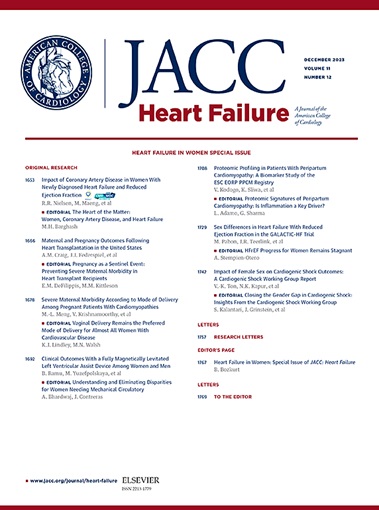射血分数轻度降低或保持的心力衰竭患者不良临床结局前的生物标志物、功能状态和生活质量的时间变化
IF 11.8
1区 医学
Q1 CARDIAC & CARDIOVASCULAR SYSTEMS
引用次数: 0
摘要
背景:在射血分数轻度降低或保持的心力衰竭患者(HFmrEF/HFpEF)出现不良临床结果之前,绘制临床、生物标志物和利尿剂给药轨迹可以为人群监测方法提供信息。目的:我们评估了两种生物标志物(n端前b型利钠肽[NT-proBNP]和估计肾小球滤过率[eGFR])、医生指定的功能状态(NYHA功能分类)、患者报告的结果(堪萨斯城心肌病问卷总症状评分[KCCQ-TSS])和导致临床事件的利尿剂剂量的时间模式。方法finhearts -HF是一项双盲、随机临床试验,在6001例左心室射血分数≥40%的症状性HF患者中检测芬芬烯酮与安慰剂。关键变量包括NT-proBNP、eGFR、NYHA功能分类、KCCQ-TSS和利尿剂剂量(以速尿当量表示)被连续评估,直到心血管死亡、首次心衰事件发生或随访期结束。每个变量都与事件发生前或随访结束前的月数相关。在随访期间,将经历临床事件的患者与存活且未住院的对照人群进行比较。结果在中位2.7年的随访期间,发生了1343例心血管死亡或首次心衰事件。在基线时,与对照人群相比,经历临床事件的参与者具有更高的NT-proBNP值,更低的eGFR,更高的NYHA功能等级,更低的KCCQ-TSS和更高的利尿剂量。eGFR下降了约5 mL/min/1.73 m2(从平均~ 57 ~ ~ 52 mL/min/1.73 m2), NT-proBNP水平在事件发生前的12 ~ 18个月内增加了约70% ~ 80%;这些指标在对照组中保持相对稳定。NYHA功能等级在事件发生前6 - 9个月急剧恶化,KCCQ-TSS在此期间下降了约6个点(从平均~ 68到~ 62),分别反映了功能等级和患者报告症状的恶化。最后,在事件发生前6个月,利尿剂剂量增加,相当于呋塞米的剂量从~ 50 mg/天增加到~ 60 mg/天。结论:在大量HFmrEF/HFpEF试验人群中,在临床事件发生前的几个月里,观察到现成的生物标志物、功能状态和患者报告的健康状况发生了具有临床意义的变化。监测这些参数可能有助于识别近期不良临床事件高风险患者。芬那烯酮试验研究心力衰竭患者优于安慰剂的疗效和安全性[FINEARTS-HF]; NCT04435626)本文章由计算机程序翻译,如有差异,请以英文原文为准。
Temporal Changes in Biomarkers, Functional Status, and Quality of Life Prior to Adverse Clinical Outcomes in Heart Failure With Mildly Reduced or Preserved Ejection Fraction
Background
Mapping clinical, biomarker, and diuretic dosing trajectories before adverse clinical outcomes in patients with heart failure with mildly reduced or preserved ejection fraction (HFmrEF/HFpEF) may inform population monitoring approaches.
Objectives
We assessed temporal patterns of 2 biomarkers (N-terminal pro-B-type natriuretic peptide [NT-proBNP] and estimated glomerular filtration rate [eGFR]), physician assigned functional status (NYHA functional class), a patient-reported outcome (Kansas City Cardiomyopathy Questionnaire Total Symptom Score [KCCQ-TSS]), and diuretic dosing leading up to a clinical event.
Methods
FINEARTS-HF was a double-blind, randomized clinical trial testing finerenone vs placebo in 6,001 patients with symptomatic HF and a left ventricular ejection fraction of ≥40%. Key variables including NT-proBNP, eGFR, NYHA functional class, KCCQ-TSS, and diuretic dosing (expressed as furosemide equivalents) were serially assessed until the occurrence of cardiovascular death, first HF event, or the end of the follow-up period. Each variable was plotted relative to the number of months before an event or the end of follow-up. Patients who experienced a clinical event were compared with a control population who remained alive and free of hospitalization during follow-up.
Results
Over a median 2.7-year follow-up period, 1,343 cardiovascular deaths or first HF events occurred. At baseline, the participants who experienced a clinical event had higher NT-proBNP values, lower eGFR, higher NYHA functional class, lower KCCQ-TSS, and higher diuretic doses compared with the control population. The eGFR declined by about 5 mL/min/1.73 m2 (from a mean of ∼57 to ∼52 mL/min/1.73 m2), and the NT-proBNP level increased by approximately 70% to 80%, in the 12 to 18 months leading up to an event; these markers remained relatively stable in the control group. NYHA functional class showed a sharp deterioration in the 6 to 9 months before an event, and KCCQ-TSS declined by approximately 6 points (from a mean of ∼68 to ∼62) during this period, reflecting worsening functional class and patient-reported symptoms, respectively. Finally, diuretic doses increased in the 6 months preceding the event, from ∼50 to ∼60 mg/day of furosemide equivalents.
Conclusions
In a large HFmrEF/HFpEF trial population, clinically meaningful changes in readily available biomarkers, functional status, and patient-reported health status were observed in the months leading up to a clinical event. Monitoring these parameters may help identify patients at high risk for near-term adverse clinical events. (Finerenone Trial to Investigate the Efficacy and Safety Superior to Placebo in Patients With Heart Failure [FINEARTS-HF]; NCT04435626)
求助全文
通过发布文献求助,成功后即可免费获取论文全文。
去求助
来源期刊

JACC. Heart failure
CARDIAC & CARDIOVASCULAR SYSTEMS-
CiteScore
21.20
自引率
2.30%
发文量
164
期刊介绍:
JACC: Heart Failure publishes crucial findings on the pathophysiology, diagnosis, treatment, and care of heart failure patients. The goal is to enhance understanding through timely scientific communication on disease, clinical trials, outcomes, and therapeutic advances. The Journal fosters interdisciplinary connections with neuroscience, pulmonary medicine, nephrology, electrophysiology, and surgery related to heart failure. It also covers articles on pharmacogenetics, biomarkers, and metabolomics.
 求助内容:
求助内容: 应助结果提醒方式:
应助结果提醒方式:


